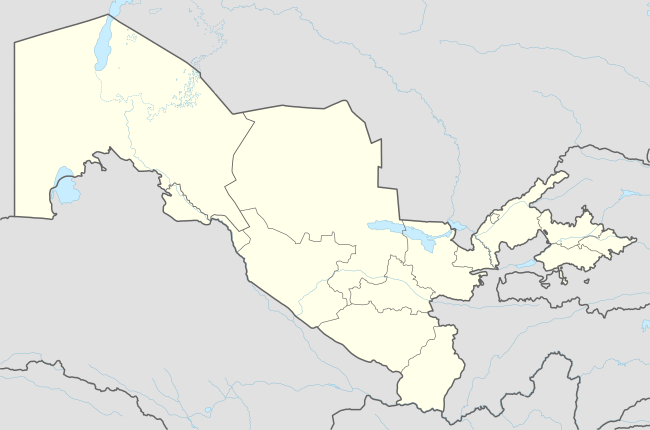Karshi-Khanabad Air Base
Karshi-Khanabad, better known as K2, is an air base in southeastern Uzbekistan, just east of Karshi. It is home to the 60th Separate Mixed Aviation Brigade of the Uzbek Air Force.
Karshi-Khanabad Air Base | |||||||||||
|---|---|---|---|---|---|---|---|---|---|---|---|
| Summary | |||||||||||
| Airport type | Military | ||||||||||
| Location | Karshi, Uzbekistan | ||||||||||
| Elevation AMSL | 1,365 ft / 416 m | ||||||||||
| Coordinates | 38°50′06″N 065°55′12″E | ||||||||||
| Map | |||||||||||
 Karshi-Khanabad Air Base Location of air base in Uzbekistan | |||||||||||
| Runways | |||||||||||
| |||||||||||
History
From 1954 to 1981, the 735th Fighter Aviation Regiment of the Soviet Air Defence Force was stationed at the base.[3] It was equipped with Mig-15 (July 1950 – 1955), MiG-17 (1955-1969), and then Sukhoi Su-9 (Fishpot) aircraft (1961-1978).[4] The regiment replaced the Su-9 in 1978 with the MiG-23M (Flogger-B).[4]
In 1981 it was renamed the 735th Fighter-Bomber Aviation Regiment, and in 1984 the 735th Bomber Aviation Regiment. Until 1984 the regiment was equipped with the MiG-23M, and from 1984-1992 with the Su-24. The regiment was under control of the Air Forces of the Turkestan Military District from April 1980 to May 1988, and then under 49th Air Army and 73rd Air Army.
On June 30, 1992, control of the base passed from the dissolved Soviet Union to Uzbekistan. From 1992 changes began to affect the regiment before it was merged with other units into the 60th Separate Mixed Aviation Brigade.
Between 2001 and 2005 7,000 Army, Air Force and Marine Corps personnel were assigned to the base,[5] also known as K2 and "Stronghold Freedom", for support missions against al-Qaeda in neighbouring Afghanistan. The 416th Air Expeditionary Operations Group was the host unit. On July 29, 2005, amid strained relations caused by the May 2005 unrest in Uzbekistan, the United States was told to vacate the base within six months. It was vacated by the United States in November 2005.[6][7][8]
Facilities
The airport resides at an elevation of 1,365 feet (416 m) above mean sea level. It has one runway designated 07/25 with a concrete surface measuring 2,498 by 40 metres (8,196 ft × 131 ft).[1]
Pollution
In November 2001, the US Army Center for Health Promotion and Preventive Medicine-Europe performed an environmental baseline survey and found widespread jet fuel plumes, usually 1–3 meters under ground, most likely from a leaking Soviet-era underground fuel distribution system and smaller, localized areas of surface dirt contaminated with asbestos and low-level radioactive processed uranium, both from the destruction of Soviet missiles several years prior.[9]
United States Armed Forces veterans who served at the base while it was used by the U.S. military described "black goo" oozing out of the soil, appearing to be a mixture of solvents, oils and other chemicals. Noxious vapors were also reported, along with radiation warning signs and a nearby pond that glowed green. Rainwater would reportedly flood tents and appeared contaminated with various chemicals. According to a 2015 Army study, 61 of the K2 veterans had been diagnosed with cancer, not counting the special operations forces.[10] The United States Department of Veteran's Affairs and U.S. Army Public Health Center had denied that an increased rate of cancers exists or that any contamination at the base posed any serious health problems.[11] The US military took steps to reduce possible sources of contamination, such as filling trenches with soil to create a cap to hold vapors underground, covering radioactive soil and asbestos,[9] which were criticized as ineffective by veterans.[10]
See also
- Karshi Airport
- Manas Air Base, Kyrgyzstan
- New Great Game
- Craig Murray
- Islam Karimov
References
- Airport information for UTSL from DAFIF (effective October 2006)
- Airport information for Karshi-Khanabad, Uzbekistan (UTSL / KSQ) at Great Circle Mapper. Source: DAFIF (effective October 2006).
- Michael Holm, '735th Bomber Aviation Regiment', accessed August 2011
- PHASEOUT OF FISHPOT IN APVO STRANYY AIRFIELDS USSR, February 1981, CREST: CIA-RDP81T00380R000100980001-5, Central Intelligence Agency, Washington, DC.
- Kime, Patricia (2020-02-27). "Post 9/11 veterans attribute deadly cancers to contaminants at US base in Uzbekistan". militarytimes. Retrieved 2020-03-03.
- "US asked to leave Uzbek airbase". BBC News. July 30, 2005.
- "Last US plane leaves Uzbek base". BBC News. November 21, 2005.
- "Ceremony to close US military base held in Uzbekistan". RIA Novosti. November 21, 2005.
- "Environmental Conditions at Karshi Khanabad (K-2) Air Base, Uzbekistan Information for Service Members and Veterans" (PDF). phc.amedd.army.mil. US Army Public Health Center. Retrieved 5 March 2020.

- Tara Copp, " Cancers strike veterans who deployed to Uzbek base where black goo oozed, ponds glowed ", Impact 2020, December 19th, 2019
- " Environmental Conditions at Karshi Khanabad (K-2) Air Base, Uzbekistan ", U.S. Army Public Health Center, n.d., Accessed December 19th, 2019